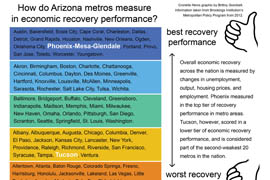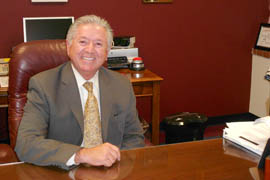Cronkite News has moved to a new home at cronkitenews.azpbs.org. Use this site to search archives from 2011 to May 2015. You can search the new site for current stories.
Report: Tucson lags behind Phoenix as state grinds way back from recession
TUCSON – As chief operating officer of the Tucson Metro Chamber, Bill Holmes promotes this city as an attractive place to do business.
Among the selling points: a university that produces large numbers of graduates in the hard sciences and math, the presence of a leading aerospace firm and an emerging downtown that will soon feature a modern streetcar.
“We have a wonderful airport here, a beautiful airport,” he said.
But it can be a tough sell. Tucson International Airport, for example, lacks the non–stop flights and lower fares of Phoenix Sky Harbor International Airport. Many of those college graduates wind up leaving for jobs elsewhere because Tucson lacks the breadth of industries that larger metropolitan areas have.
After years of recession, the economy here remains sluggish.
“We’re not on an all–right track,” Holmes said. “Employment is the lagging indicator. Businesses are sitting on a lot of money, and it’s that vicious cycle. Until people start spending more the businesses aren’t going to start hiring more.”
A recent report by the Brookings Institution found that the Tucson metropolitan area trails the Phoenix metropolitan area in economic recovery.
It rated the recovery of 100 metropolitan areas around the U.S. in groups of 20. Phoenix ranked in the highest–performing group of 20; Tucson was in the second to last group of 20.
The report took into account changes in employment, unemployment, output and home prices.
Kenan Fikri, the report’s co–author, said the Phoenix area has benefited from growth in the health care and education sectors.
“The big distinction between Phoenix and Tucson is that Phoenix has a growth sector and Tucson does not,” he said.
Robert Medler, vice president of government affairs for the Tucson Metro Chamber, said the Valley of the Sun has the inherent advantages of a megapolitan area, such as a diversity of industries and jobs associated with them. Tucson, meanwhile, is particularly strong in aerospace and military.
“The tipping point for the wealth and the job creation that comes with that wealth, it’s already there in Phoenix, in Houston, in D.C., in Boston, in New York, in Los Angeles…,” Medler said. “They already have enough broad base in their economy to where when things are going to turn around and pick up, they’re going to grow a lot quicker because they already have all of the components.”
The Brookings Institution report said that a 4.9 percent increase in housing prices from the trough in the second quarter of 2011 helped elevate the Phoenix area. Housing prices in the Tucson rose 1.5 percent in that period.
Employment in Phoenix rose 2.4 percent from the trough in the third quarter of 2010, while employment in Tucson rose 1.5 percent during that period.
Marshall Vest, an economist at the University of Arizona’s Eller College of Management, said it’s unlikely that the Tucson area’s economy will ever rival that of Phoenix.
“In the long term, Tucson grows more slowly than Phoenix,” Vest said. “If you look at the long–term average, Tucson grows at about two–thirds of the rate Phoenix grows.”
Calling it a good sign that both metropolitan areas are adding jobs, Vest said he expects job growth to increase as the recovery continues. But he doesn’t expect Arizona’s economy to be back to where it was before the recession until 2015 or 2016.
“There’s still a lot of growth on Arizona’s horizon,” he said.










